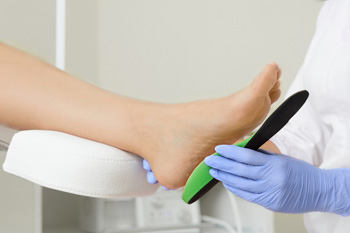
Custom-made foot and ankle orthotics play a vital role in diabetic foot care by addressing the unique challenges posed by this condition. Diabetes can lead to peripheral neuropathy and impaired circulation, leaving the feet vulnerable to injuries and ulcers. Left untreated, these complications can escalate, potentially resulting in severe infections, tissue damage, and possibly amputation. Orthotics designed specifically for diabetic patients offer several benefits. They help redistribute pressure away from areas prone to ulceration, thereby reducing the risk of wounds. Additionally, orthotics can improve stability and alignment, which is helpful for preventing falls and injuries. By providing cushioning and support, they also alleviate discomfort and pain associated with diabetic neuropathy. If you have diabetic foot issues, it is suggested that you schedule an appointment with a podiatrist to discuss whether orthotics can help you.
If you are having discomfort in your feet and would like to try orthotics, contact one of our podiatrists from Associates in Podiatry. Our doctors can provide the care you need to keep you pain-free and on your feet.
What Are Orthotics?
Orthotics are inserts you can place into your shoes to help with a variety of foot problems such as flat feet or foot pain. Orthotics provide relief and comfort for minor foot and heel pain but can’t correct serious biomechanical problems in your feet.
Over-the-Counter Inserts
Orthotics come in a wide variety of over-the-counter inserts that are used to treat foot pain, heel pain, and minor problems. For example, arch supports can be inserted into your shoes to help correct overarched or flat feet, while gel insoles are often used because they provide comfort and relief from foot and heel pain by alleviating pressure.
Prescription Orthotics
If over-the-counter inserts don’t work for you or if you have a more severe foot concern, it is possible to have your podiatrist prescribe custom orthotics. These high-quality inserts are designed to treat problems such as abnormal motion, plantar fasciitis, and severe forms of heel pain. They can even be used to help patients suffering from diabetes by treating foot ulcers and painful calluses and are usually molded to your feet individually, which allows them to provide full support and comfort.
If you are experiencing minor to severe foot or heel pain, it’s recommended to speak with your podiatrist about the possibilities of using orthotics. A podiatrist can determine which type of orthotic is right for you and allow you to take the first steps towards being pain-free.
If you have any questions please contact our offices located in Pittsburgh-South Hills, and Pittsburgh-Bellevue, PA . We offer the newest diagnostic and treatment technologies for all your foot and ankle needs.


